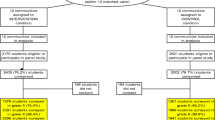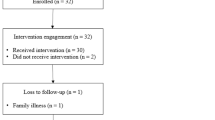This study examined parents’ perceived barriers to participation in a multicomponent prevention program implemented by a community agency serving culturally diverse urban neighborhoods. The Early Risers Participation Interview (ER-PI), modeled after Kadzin et al.'s (1997) Barriers to Treatment Participation Scale, was administered to parents (N=138) of children who were screened for disruptive behavior and were randomized into a two-year intervention condition. Results showed that the perceived barriers score provided significant information in differentiating low and high participators after controlling for child, parent, and family characteristics. Early identification and resolution of parents’ perceived barriers to participation may be key to implementing multifaceted preventive programs successfully in inner-city neighborhoods.
Editor's Strategic Implications: The authors present promising practices for client engagement and retention. The experimental, longitudinal design is notable, especially in the evaluation of a community-run prevention program.
Similar content being viewed by others
Notes
A three-factor structure of the measure, combining stressors/obstacles and demand domains, was tested to examine if the three-factor structure would yield a better fit. Fit indices did not meet the goodness of fit criteria.
Because of missing data in the independent variables, total number of participants included in the logistic analyses was N=114. There were no significant baseline characteristic differences between those who were included in the analysis and those who were excluded due to missing data. When missing values were imputed using the expectation maximization algorithm and all participants (N=138) were included in the analyses, results yielded same significant findings as those reported in the Results section.
References
Armbruster, P., & Kazdin, A. E. (1994). Attrition in child psychotherapy. In T. H. Ollendick & R. J. Prinz (Eds.), Advances in clinical psychology: Vol. 16 (pp. 81–108). New York: Plenum.
August, G. J., Hektner, J. M., Egan, E. A., Realmuto, G. M., & Bloomquist, M. L. (2002). The Early Risers longitudinal prevention trial: Examination of 3-year outcomes in aggressive children with intent-to-treat and as-intended analyses. Psychology of Addictive Behaviors, 16, 27–39.
August, G. J., Lee, S. S., Bloomquist, M. L., Realmuto, G. M., & Hektner, J. M. (2003). Dissemination of an evidence-based preventive innovation for aggressive children living in diverse, urban neighborhoods. Prevention Science, 4, 271–286.
August, G. J., Lee, S. S., Bloomquist, M. L., Realmuto, G. M. & Hektner, J. M. (2004). Maintenance effects of an evidence-based preventive innovation for aggressive children living in culturally diverse, urban neighborhoods: The Early Risers effectiveness study. Journal of Emotional and Behavioral Disorders, 12, 194–205.
August, G. J., Realmuto, G. M., Hektner, J. M., & Bloomquist, M. L. (2001). An integrated components preventive intervention for aggressive elementary school children: The Early Risers program. Journal of Consulting and Clinical Psychology, 69, 614–626.
August, G. J., Winters, K. C., Realmuto, G. M., Tarter, R., Perry, C., & Hektner, J. M. (2004). Moving evidence-based drug abuse prevention programs from basic science to practice: “Bridging the efficacy-effectiveness interface.” Substance Use & Misuse, 39, 2017–2053.
Barrrera, M., Biglan, A., Taylor, T. K., Gunn, B. K., Smolkowski, K., Black, C., et al. (2002). Early elementary school intervention to reduce conduct problems: A randomized trial with Hispanic and non-Hispanic children. Prevention Science, 3, 83–94.
Beck, A. T., Steer, R. A., & Brown, G. K. (1996). Beck depression inventory manual (2nd edn.). San Antonio, TX: Psychological Corp.
Bloomquist, M. L., August, G. J., Lee, S. S., Berquist, B. E., & Mathy, R. (2005). Targeted prevention of antisocial behavior in children: The Early Risers “Skills for Success” Program. In R. G. Steele & M. C. Roberts (Eds.), Handbook of mental health services for children, adolescents, and families (pp. 201–214). New York: Kluwer-Academic/Plenum Publishers.
Conduct Problems Prevention Research Group (1999). Initial impact of the Fast Track prevention trial for conduct problems: I. The high-risk sample. Journal of Consulting and Clinical Psychology, 67, 631–647.
Conduct Problems Prevention Research Group (2002). The implementation of the Fast Track Program: An example of a large-scale prevention science efficacy trial. Journal of Abnormal Psychology, 30, 1–17.
Duran, B., Oetzel, J., Lucero, J., Jiang, Y., Novins, D. K., Manson, S., et al. (2005). Obstacles for rural American Indians seeking alcohol, drug, or mental health treatment. Journal of Consulting and Clinical Psychology, 73, 819–829.
Gorman-Smith, D., Tolan, P. H., Henry, D. B., Leventhal, A., Schoeny, M., Lutovsky, K., et al. (2002). Predictors of participation in a family-focused preventive intervention for substance use. Psychology of Addictive Behaviors, 16(4S), S55–S64.
Henggeler, S. W. (1999). Multisystemic therapy: An overview of clinical procedures, outcomes and policy implications. Child Psychology and Psychiatry Review, 4, 2–10.
Henggeler, S. W., Pickrel, S. G., Brondino, M. J., & Crouch, J. L. (1996). Eliminating (almost) treatment dropout of substance abusing or dependent delinquents through home-based multisystemic therapy. American Journal of Psychiatry, 153, 427–428.
Hollingshead, A. (1975). Four factor index of social status. New Haven, CT: Yale University.
Kazdin, A. E., Holland, L., & Breton, S. (1991). Barriers to Participation in Treatment Scale-Parent and therapist versions. New Haven, CT: Yale University.
Kazdin, A. E., Holland, L., & Crowley, M. (1997). Family experience of barriers to treatment and premature termination from child therapy. Journal of Consulting and Clinical Psychology, 65, 453–462.
Kazdin, A. E., Holland, L., Crowley, M., & Breton, S. (1997). Barriers to treatment participation scale: Evaluation and validation in the context of child outpatient treatment. Journal of Child Psychology and Psychiatry, 38, 1051–1062.
Kazdin, A. E., & Mazurick, J. L. (1994). Dropping out of child psychotherapy: Distinguishing early and late dropouts over the course of treatment. Journal of Clinical Child Psychology, 62, 1069–1074.
Kazdin, A. E., Stolar, M. J., & Maricano, P. L. (1995). Risk factors for dropping out of treatment among white and black families. Journal of Family Psychology, 9, 402–417.
Kinney, J. D., & Ditmar, K. (1995). Homebuilders: Helping families help themselves. In I. M. Schwartz & P. AuClaire (Eds.), Home-based services for troubled children (pp. 29–54). Lincoln, NE: University of Nebraska Press.
Lochman, J. E., & the Conduct Problems Prevention Research Group (1995). Screening of child behavior problems for prevention programs at school entry. Journal of Consulting and Clinical Psychology, 6, 549–559.
McKay, M. M., Gonzales, J. J., Stone, S., Ryland, D., & Kohner, K. (1995). Multiple family therapy groups: A responsive intervention model for inner city families. Social Work With Groups, 18, 41–56.
McKay, M. M., McCadam, K., & Gonzales, J. J. (1996). Addressing the barriers to mental health services for inner city children and their caretakers. Community Mental Health Journal, 32, 353–361.
Miller, G. E., & Prinz, R. J. (2003). Engagement of families in treatment for childhood conduct problems. Behavioral Therapy, 34, 517–534.
Morrissey-Kane, E., & Prinz, R. J. (1999). Engagement in child and adolescent treatment. The role of parent cognitions and attributions. Clinical Child and Family Psychology Review, 2, 183–196.
Nock, M. K., & Kazdin, A. E. (2001). Parent expectancies for child therapy: Assessment and relation to participation in treatment. Journal of Child and Family Studies, 10, 155–180.
Orrell-Valente, J. K., Pinderhughes, E. E., Valente, E., & Laird, R. D. (1999). If it's offered, will they come? Influences on parents' participation in a community-based conduct problems prevention program. American Journal of Community Psychology, 27, 753–783.
Prinz, R. J., Smith, E. P., Dumas, J. E., Laughlin, J. E., White, D. W., & Barron, R. (2001). Recruitment and retention of participants in prevention trials involving family-based interventions. American Journal of Preventive Medicine, 20(Suppl 1), 31–37.
Reid, J. B., Eddy, J. M., Fetrow, R. A., & Stoolmiller, M. (1999). Description and immediate Impacts of a preventive intervention for conduct problems. American Journal of Community Psychology, 27, 483–517.
Sanders, M. R. (1999). Triple-P Positive Parenting Program: Towards an empirically validated Multilevel parenting and family support strategy for the prevention of behavior and emotional problems in children. Clinical Child and Family Psychology Review, 2, 71–90.
Snell-Johns, J., Mendez, J. L., & Smith, B. H. (2004). Evidence-based solutions for overcoming access barriers, decreasing attrition, and promoting change with underserved families. Journal of Family Pyschology, 18, 19–35.
Spoth, R., Ball, A. D., Klose, A., & Redmond, C. (1996). Illustration of a market segmentation technique using family-focused prevention program preference data. Health Education Research, 11, 259–267.
Spoth, R., Goldberg, C., & Redmond, C. (1999). Engaging families in longitudinal preventive intervention research: Discrete-time survival analysis of socioeconomic and social-emotional risk factors. Journal of Consulting and Clinical Psychology, 67, 157–163.
Spoth, R., & Redmond, C. (1993). Study of participation barriers in family-focused prevention: Research issues and preliminary results. International Quarterly of Community Health Education, 13, 365–388.
Spoth, R., & Redmond, C. (1995). Parent motivation to enroll in parenting skills programs: A model of family context and health belief predictors. Journal of Family Psychology, 9, 294–310.
Spoth, R., & Redmond, C. (2000). Research on family engagement in preventive interventions: Toward improved use of scientific findings in primary prevention practice. Journal of Primary Prevention, 21, 267–284.
Spoth, R., Redmond, C., Hockaday, C., & Shin, C. Y. (1996). Barriers to participation in family skills preventive interventions and their evaluations: A replication and extension. Family Relations, 45, 247–254.
Webster-Stratton, C. (1994). Advancing videotape parent training: A comparison study. Journal of Consulting and Clinical Psychology, 62, 583–593.
Webster-Stratton, C. (1996). Early intervention with videotaped modeling: Programs for families of children with oppositional defiant or conduct disorder. In E. D. Hibbs & P. S. Jensen (Eds.), Psychosocial treatments for child and adolescent disorders: Empirically based strategies for clinical practice (pp. 435–474). Washington, DC: American Psychological Association.
Werthamer-Larsson, L., Kellam, S. G., & Wheeler, L. (1991). Effects of first grade classroom environment on shy behavior, aggressive behavior, and concentration problems. American Journal of Community Psychology, 19, 585–602.
Winn, D. C., & Herman, M. G. H. (2004). Research meets the real world: Lessons learned in three community implementations of Fast Track. In J. B. Kupersmidt & K. A. Dodge (Eds.), Children's peer relations: From development to intervention (pp. 223–240). Washington, DC: American Psychological Association Press.
Acknowledgment
This study was supported by an award from the National Institute of Mental Health [MH 63328].
Author information
Authors and Affiliations
Corresponding author
Rights and permissions
About this article
Cite this article
Lee, S.S., August, G.J., Bloomquist, M.L. et al. Implementing an Evidence-Based Preventive Intervention in Neighborhood Family Centers: Examination of Perceived Barriers to Program Participation. J Primary Prevent 27, 573–597 (2006). https://doi.org/10.1007/s10935-006-0060-x
Published:
Issue Date:
DOI: https://doi.org/10.1007/s10935-006-0060-x




